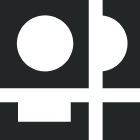In a nutshell:
- Predictive analytics tools help businesses understand and use data to drive growth.
- These tools offer insights into customer behavior, increase sales opportunities, optimize lead segmentation, improve ROI, and enhance operational efficiency.
- The six best predictive analytics platforms in 2024 are Pecan, Qlik Sense, SAS Advanced Analytics, Oracle Crystal Ball, Alteryx, and Tableau.
- Pecan is a leading low-code solution that doesn't require data scientists and offers customizable templates for predictive models. Its Predictive GenAI features put it a step ahead in accessibility.
- Each tool has its own strengths and limitations, so it's important to choose one that aligns with your goals, budget, and data infrastructure.
Everyone says data is king.
But they’re wrong.
Data alone isn’t enough to help businesses move forward.
It’s understanding the data and knowing how to use it that help businesses grow.
Predictive analytics tools are essential to understanding and using your business data to help you see what the future holds.
This type of software helps you leverage the power of historical (and current) data to understand trends, forecast incoming revenue, and optimize marketing strategies.
Predictive analytics tools have immense potential to shape your business and help you achieve your most critical KPIs. You can make your data do more, no matter your industry or how you interact with customers. For example, use your data to reach customers more effectively, provide them with the offers and products they need and want at the right time, and improve your bottom line.
In this guide, we’ll break down the six best predictive analytics platforms on the market today so you can decide on the right one for you and your business goals.
What are predictive analytics tools?
Before we discuss the different tools, let’s examine predictive analytics and its impact on marketing and business growth strategy.
Predictive analytics is the practice of using present and past data to predict business outcomes.
The process of predictive analytics combines a variety of methods, including statistical techniques and advanced analytics, in order to forecast marketing performance, forecast demand, optimize campaigns, retain customers, cross-sell products, and more.
Keep in mind — predictive analytics tools aren’t prophetic. They can’t offer guaranteed outcomes. What they can do is offer reliable probabilities of results.
As a single part of the greater advanced analytics game, predictive analytics uses statistics and machine learning to forecast a specific event’s likelihood.
While mathematics and data science are the building blocks of predictive analytics, many modern predictive analytics platforms like Pecan AI don’t require users to be data scientists.
Most predictive analytics tools are both advanced enough that data scientists can get the most out of them and simple enough that business people without a data background can understand the predictions to make effective business decisions.
Advantages of using a predictive analytics tool
Did you know that experts think the predictive analytics market will reach $67.66 billion by 2030? The global market is growing at a compound annual growth rate (CAGR) of 24.4 percent.
There’s no doubt this type of prediction software is becoming an increasingly important part of business strategy. Check out some examples from the Harvard Business School — we hear they're pretty astute about business success.
Investing in these tools has proven highly worthwhile for companies who adopt a predictive analytics practice, not just an imprecise data-informed approach. In fact, Pecan AI customers have seen impressive results when using our low-code predictive analytics solution:
- E-Commerce Brand: A well-known e-commerce company built and deployed a predictive analytics upsell model within two weeks, doubling their campaign conversion rates.
- CPG Brand: A household CPG brand detected roughly 85% of customer churn and markedly lowered global churn by over 10%.
- Mobile Gaming Company: A mobile gaming company was likewise able to identify VIP customers and improve the lifetime value of their users, with a 3.5X uplift in spending per user.
Whether a Fortune 500 brand or an SMB, your business can leverage predictive analytics software for the same reasons. Overall, using a future-driven approach in your everyday operations will boost your outcomes.
The question is: What are the benefits of leveraging predictive analytics software?
-
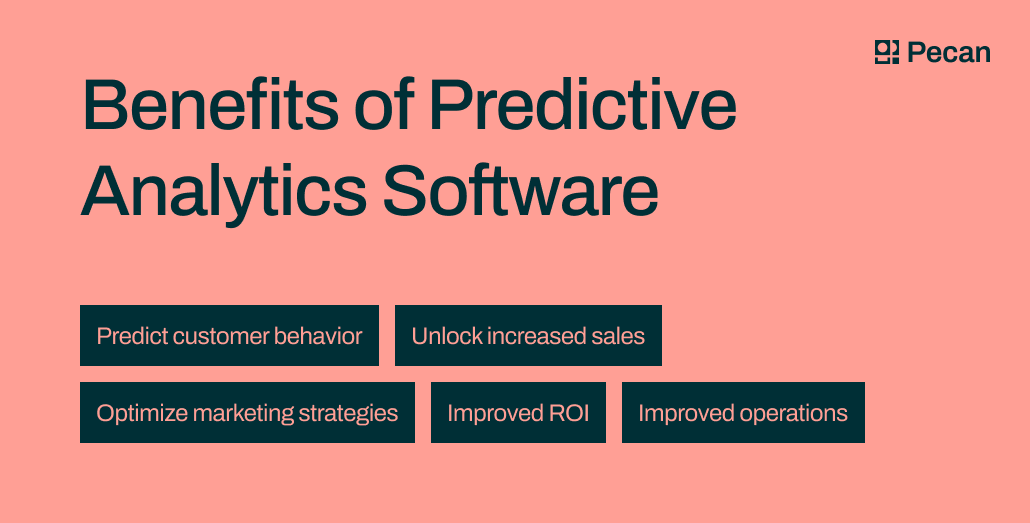
- The benefits of implementing predictive analytics software
1. Predict customer behavior
To grow your business, you need to reach your target market effectively. But if you don’t know your audience, your competitors who do know them will win them over.
One of the biggest benefits of predictive analytics software is that it helps you better understand your customers. By leveraging historical data through a platform, you’ll gain insights into your customers’ past and future behaviors and how those behaviors change throughout the customer journey.
With that knowledge, you’ll be better able to spot potential roadblocks in your marketing and customer engagement efforts so you can improve your strategy.
2. Unlock increased sales
By leveraging historical data, a predictive analytics platform can help you identify products and services your customers have bought from you in the past to help predict what they’ll need in the future.
Understanding past purchase behavior can help you see which customers are most likely to be interested in upsell and cross-sell offers to provide more value, generate repeat purchases, and improve average order value.
3. Optimize marketing strategies
With predictive analytics, you can anticipate customers' lifetime value early — as soon as 24 to 48 hours after launching a new marketing campaign. With that information, you can discover a campaign’s total value and likely return on ad spend (ROAS) early by predicting and aggregating customer lifetime value – one, three, six, or more months out.
Additionally, you can ensure your marketing budget is allocated ideally using machine learning-powered marketing mix modeling. You can optimize every dollar of marketing spend to ensure it's making the biggest possible impact on the outcomes that matter most to you, whether that's sales, leads, inbound inquiries, or other metrics.
4. Improved ROI
Predictive analytics tools can be a great way to convert more leads into customers, encourage repeat purchases, and increase average order value. You can also use them to reduce your churn rate so customers stay customers longer.
Business teams can use a self-service predictive analytics platform to identify and score leads more likely to convert based on past data. This can help them optimize strategy and resource allocation for the best possible results.
Predictive analytics can help you not only convert customers more quickly but also encourage them to spend more during their time with you. Overall, this technology can give you a greater return on investment (ROI) on your investment in acquiring customers and retaining them.
5. Improved operations
Leveraging predictive analytics software doesn’t just have monetary benefits like improved revenue, ROI, and profitability. It’s also a great way to improve your operational efficiency.
By integrating predictive analytics into your day-to-day business processes, you’ll be able to make better decisions and prioritize the actions that will yield the best outcome. Your organization will be focused on high-impact actions, improving your team’s overall productivity.
6 best predictive analytics tools
This section will look at six of the best predictive analytics platforms you can use to kickstart or upgrade your predictive analytics journey.
We’ll describe each predictive analytics software's capabilities, key features and integrations, pros and cons, and pricing so you can choose the right one for your needs.
Best Predictive Analytics Tool #1: Pecan AI
Pecan is an AI-driven predictive analytics platform that helps marketing, sales, and operations teams predict business outcomes. Founded in 2018, the low-code predictive analytics and data science platform enables organizations to leverage the full power of AI and predictive modeling without requiring a data scientist.
-
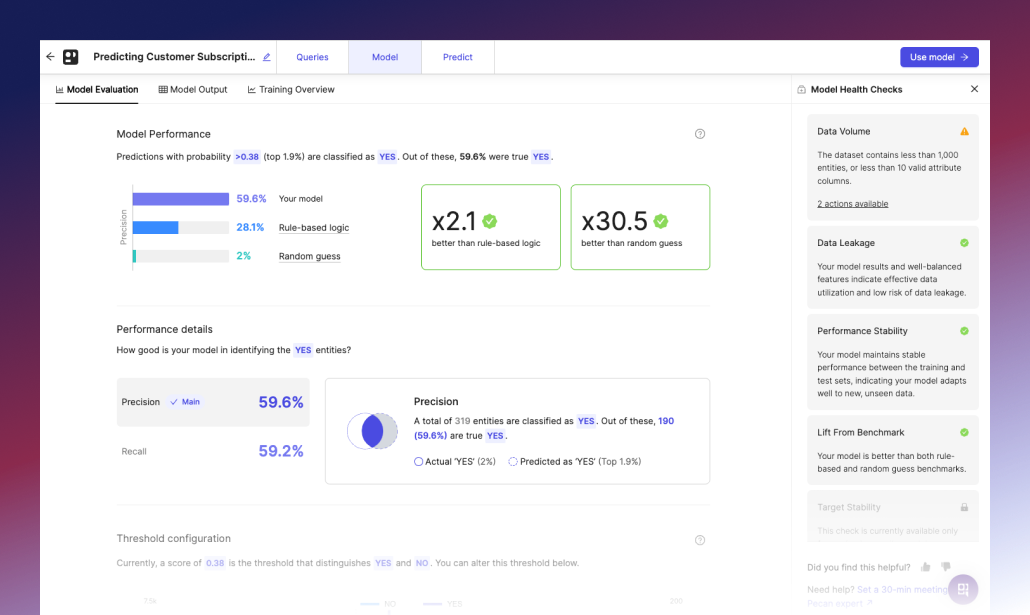
- Pecan’s predictive analytics software
Why Pecan AI: Pecan is the leading low-code predictive analytics solution. While most predictive analytics platforms require a development team to function, Pecan enables non-techies to forecast business outcomes with ease. The software's Predictive GenAI capabilities allow you to start a predictive model with a chat and use automatically generated SQL code to kick off the modeling process.
Pecan AI features include predictive return on advertising spend (ROAS), AI-driven predictive analytics, automated data prep, predictive model building, model monitoring, and actionable predictions for specific business goals, as well as customizable templates for predictive models like conversion, LTV, and customer churn.
Pecan AI integrations include Salesforce, Oracle, Snowflake, Amazon S3, IBM Db2, Singular, AppsFlyer, Firebase, Adjust, Google BigQuery, PostgreSQL, and Microsoft SQL Server.
Pricing: From $50 per month with a 14-day free trial.
What it’s great at:
- Fast modeling and data integration
- AI automates several predictive analytics processes
- Low-code interface is great for non-techies or small teams
- Easy predictive model implementation
- Automated data prep, model building, deployment, feature engineering, and model monitoring
- No need for an in-house data scientist
- Customizable model templates
- Hyper-specific predictions for goals
Areas of limitation:
- Dashboard can take some getting used to
- Higher starting price point
Best Predictive Analytics Tool #2: Qlik Sense
Qlik Sense is a data science tool that’s also great for predictive analytics. Founded in 1993, the software can quickly generate machine learning models and explore several “what-if” scenarios with its code-free user interface.
-

- Qlik
Why Qlik Sense: Qlik is a great tool for anyone who doesn’t have any coding experience. Small business owners and enterprise organizations can use it to conduct experiments and mine data to identify key drivers in your models.
Qlik Sense features include augmented analytics, advanced AI modeling, smart visualization, a mobile app, flexible APIs, self-service analysis creation, and alerts for data changes.
Qlik Sense integrations include Databricks, MongoDB, RowShare, Smartsheet, Snowflake, SysAid, Amazon Web Services, and TOPdesk.
Pricing: From $20/month with a 30-day free trial.
What it’s great at:
- Interface is easy to use
- Plenty of customization options
- Quick to implement
- Enterprise option available
- Industry-specific solutions
Areas of limitation:
- Data modeling is limited
- Navigation could be improved
Best Predictive Analytics Tool #3: SAS Advanced Analytics
SAS is a global software company founded in 1976. Headquartered in North Carolina, the company offers a variety of predictive analytics tools, including SAS Advanced Analytics. This software generates models for future probabilities of outcomes.
-

- SAS
Why SAS Advanced Analytics: The tool offers marketing leaders and data scientists a robust infrastructure of analytics features to run quick simulations and get quick results. The platform offers coding and no-code predictive analytics, depending on your level of expertise. It’s great for new organizations and those scaling that need an option that grows with them.
SAS Advanced Analytics features include data mining, data analysis, data interactions, scripting tools, data governance that tracks data and model lineage for simple data retraining, data visualization, knowledge base, and report generation.
SAS Advanced Analytics integrations include open-source integrations via various APIs, allowing you to align the software with your current technology setup.
Pricing: Upon request, with a 14-day free trial.
What it’s great at:
- Can process large amounts of data
- Great for data exploration
- Can build machine learning algorithms
- Easy to use once set up
Areas of limitation:
- Quite expensive
- Can take some time to set up
Best Predictive Analytics Tool #4: Oracle Crystal Ball
Oracle is one of the biggest software companies in the world, known for its wide array of products. The software conglomerate’s predictive analytics solution, Crystal Ball, is great for simulating spreadsheet models.
-
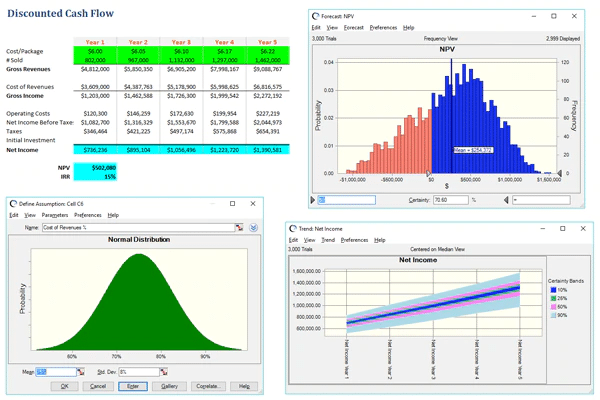
- Oracle Crystal Ball
Why Oracle Crystal Ball: If you like spreadsheets, then you’ll love Crystal Ball. Oracle designed it to be an exhaustive spreadsheet app for forecasting, optimization, and simulation. The tool is excellent for helping marketing leaders predict campaign outcomes through various spreadsheets.
Oracle Crystal Ball features include data visualizations, an OptQuest developer kit, data unification, data interactions, report generation, time series forecasting, optimization, and Monte Carlo simulations.
Oracle Crystal Ball integrations include Excel.
Pricing: Single purchase of $1,100 ($410 for students or faculty) with a free trial.
What it’s great at:
- Great for spreadsheet users
- Variety of templates available
- Classroom edition for the academic community
- User-friendly interface
- Low barrier to entry
- Easy-to-read data visualization
Areas of limitation:
- Excel version crashes occasionally
- UI looks a bit outdated for some users
Best Predictive Analytics Tool #5: Alteryx
Alteryx is an all-in-one, self-service predictive analytics platform with robust forecasting and automation features. Founded in 1997, the predictive analytics solution serves thousands of customers worldwide, including Netflix, Salesforce, P&G, and Nestle.
-
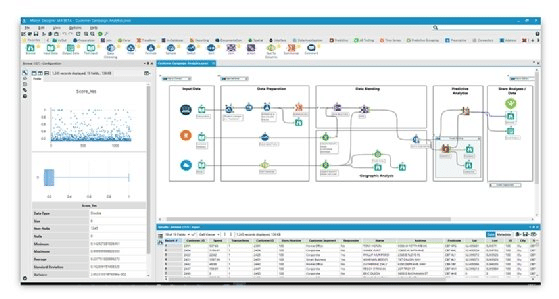
- Alteryx
Why Alteryx: Alteryx delivers end-to-end automated analytics, data science processes, and machine learning to help businesses unlock hidden business and marketing insights to build reliable predictions. The platform is great at pulling data from multiple sources and tools to give teams business insights without needing coding experience.
Alteryx features include automated machine learning model creation, advanced analytics with built-in Python integration, visual text mining, NLP capabilities, drag-and-drop data prep, code-free automation building blocks, data cleaning and blending, and data extraction from structured and unstructured sources. Some of these features require additional paid upgrades and are not included in the core Alteryx Designer software.
Alteryx integrations include Amazon S3, Google BigQuery, Snowflake, Shopify, Salesforce, JSON, Excel, Google Analytics, HubSpot, Facebook Ads, and Mailchimp.
Pricing: From $4,950/user/year for the Designer version with a 30-day free trial.
What it’s great at:
- Over 80 native integrations
- No coding experience is necessary
- Easy to use
- Variety of macros to automate processes
- Active Alteryx support community
Areas of limitation:
- Very expensive compared to other tools
- Requires manual data cleansing for best results
- Not the best data visualization
- Some bugs
Best Predictive Analytics Tool #6: Tableau
In 2003, Stanford researchers created Tableau as a result of a computer science project. The web and cloud-based predictive analytics tool is designed to offer data-driven experiences and insights to help you optimize your strategy through data visualization.
-
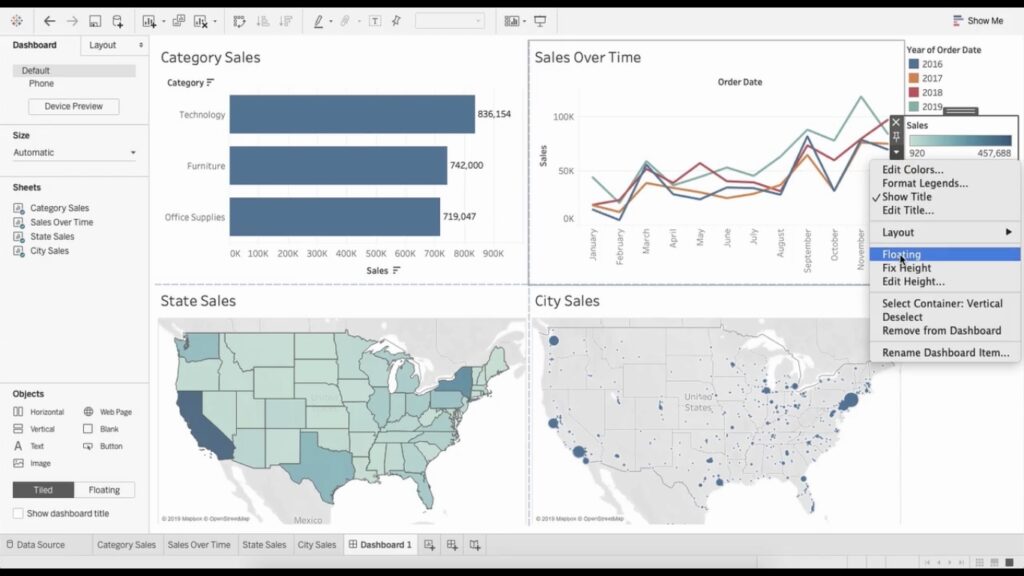
- Tableau
Why Tableau: Tableau is a data visualization solution for a variety of users — from freelancers to enterprise organizations. It also includes some predictive analytics capabilities, drawing on parent company Salesforce’s Einstein AI.
Tableau features include data visualization and interpretation, big data services, collaboration tools, automated modeling, data discovery, desktop tools, cloud tools, reports interface and dashboard, and on-premises servers.
Tableau integrations include Amazon Redshift, Vertica, PostgreSQL, Splunk, Salesforce, Snowflake, Google Analytics, Amazon Athena, Google BigQuery, and Hive.
Pricing: From $15/month with a 14-day free trial.
What it’s great at:
- Visual data is easy to understand
- Easily accessible through any device
- Easy drag-and-drop builder
- Quick insights
Areas of limitation:
- Steep learning curve
- Mobile app has limited features
Leverage AI to take your predictive analytics to the next level
If you’re struggling to optimize critical business outcomes in marketing, supply chain, sales, or elsewhere in your organization, predictive analytics can be a game changer.
Predictive analytics tools help you better understand your audience and business activities, so you can determine which actions bring the most value to them and your organization.
By understanding what’s to come through predictive analytics, you can optimize your marketing campaigns, better allocate resources, and improve your overall performance.
While we discussed the top tools available today, it’s crucial your chosen software is compatible with your goals, budget, and data infrastructure.
If you’re looking for an AI-driven predictive analytics platform that doesn’t require data scientists or developers, then you’ll want to check out Pecan AI.
If you’re looking to get started in predictive analytics, we created a helpful guide. The guide leads you and other stakeholders through gathering information and making decisions about your predictive analytics strategy.
Want to dive into one of the best predictive analytics tools right away? Sign up for a free trial of Pecan today, or let us give you a guided tour.
